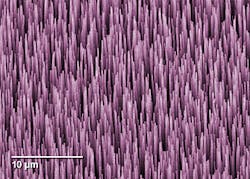Boulder, CO--A fiber-coupled cryogenic radiometer created by researchers at the National Institute of Standards and Technology (NIST) takes absolute measurements of optical power delivered through an optical fiber.1
The device links optical fiber power measurements directly to fundamental electrical units and national standards. It uses a dense thicket of carbon nanotubes (CNTs) to measure values that are about one-thousandth of the levels typically attained with a cryogenic radiometer lacking direct fiber-input capability. With improvements in temperature control and speed, the device could meet the needs for ultraprecise calibrations at ultralow power in optical communications, medical devices, and other industries. The demonstration is also a step toward converting radiometry from a classical practice based on electrical units to a quantum practice based on single photons.
"We have many customers who request optical power measurements in fiber, mainly for optical communications," says project leader John Lehman. "Also, our single-photon measurements are done in fiber."
The new radiometer is about 70 mm long and incorporates a 1.45-mm-thick optical fiber capped by a light-trapping cavity at one end with the nanotube absorber and a heater. The nanotubes are grown on an X-shaped piece of micromachined silicon. Light absorption was so high it was difficult to determine measurement uncertainties; Lehman travelled to a special facility at the National Physical Laboratory (the British equivalent of NIST) to make certain measurements.
Experiments and calculations indicate the new radiometer can measure a power level of 10 nW with an uncertainty of 0.1%. By comparison, typical measurements of optical power delivered through fiber have an uncertainty of 3% or more at similar power levels. More importantly, these commercial devices rely on a series of calibrations to establish traceability to national standards.
NIST aims to develop an absolute quantum standard for optical power and energy based on single photons. The effort includes development of sources and detectors spanning a wide range of optical power measurements, from single photon counts to trillions of photons.
REFERENCES
1. D. Livigni et al., "Fiber-coupled cryogenic radiometer with carbon nanotube absorber," paper presented at 11th International Conference on New Developments and Applications in Optical Radiometry (NEWRAD 2011), Maui, Hawaii, Sept. 19-23, 2011.
2. D. Livigni et al., "Optical fiber-coupled cryogenic radiometer with carbon nanotube absorber," Metrologia; forthcoming.
Also see the 2010 NIST Tech Beat article, "Extreme Darkness: Carbon Nanotube Forest Covers NIST's Ultra-dark Detector" at http://www.nist.gov/pml/div686/dark_081710.cfm.

